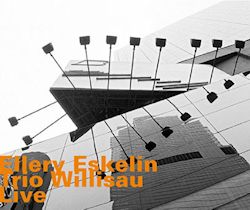On (or about)
My Melancholy Baby
Blue and Sentimental
East of the Sun
We See
I Don’t Stand a Ghost of a Chance with you
Ellery Eskelin is something of a near-regular at Switzerland’s Willisau Jazz Festival. In place of the expected Gerald Cleaver at the drums, we have Gerry
Hemingway instead, a gloss on the saxophone player’s Trio New York. The notes talk of a 51-minute first track and whilst it’s true that it is indeed
single-tracked and does last that long, it’s clearly subdivided into four song titles, three of them standards and one by the trio itself. The index point
is there for convenience’s sake, not because the trio splurged with Rollins-like profligacy. Eskelin makes his first appearance around the five-minute mark
after Hemingway’s almost subterranean drumming has generated its own level of expectancy and Gary Versace’s Hammond B3 work has lent its own very
idiosyncratic sense of colour to the proceedings. The echoes, reflections and refractions this trio show are a product of mutual empathy and quickness of
instinct.
Occasionally this is crabby but as often as not there’s an incipient romanticism and the way the trio eases from On (or about) into My Melancholy Baby is as distinctive as it is arresting, the music balancing warmth with rhythmic excitement and a genuine sense of playfulness.
The segueing from one to another creates a suite-like structure, and allows the leader’s expansive Hawkins lineage finally to emerge in all its richness of
tone and profile, his languorous breathing also evoking Ben Webster. The assimilation of these classic forefathers into a contemporary trio context works
decidedly well. But this is a trio that can afford to strip its ensemble sound right down – via dynamics and leaving spaces – to allow monologues and
dialogues, soliloquising paragraphs that add to the direction of the music and create a structure that is wholly admirable. The trio can therefore catch
the spare ensemble of Monk’s We See, with its shifting angular lines, and in the final track, I Don’t Stand a Ghost of a Chance with you, Versace’s Hammond rumbles and yearns darkly and dankly, whilst the music’s lyric curve turns
appropriately bluesy.
We are blessed with a number of high profile, independent minded trios, whether piano-led, or as here, saxophone. Eskelin’s rapport with Versace and
Hemingway is powerful, indeed prodigious, and this live concert performance entertains, enlightens, and moves.
Jonathan Woolf
